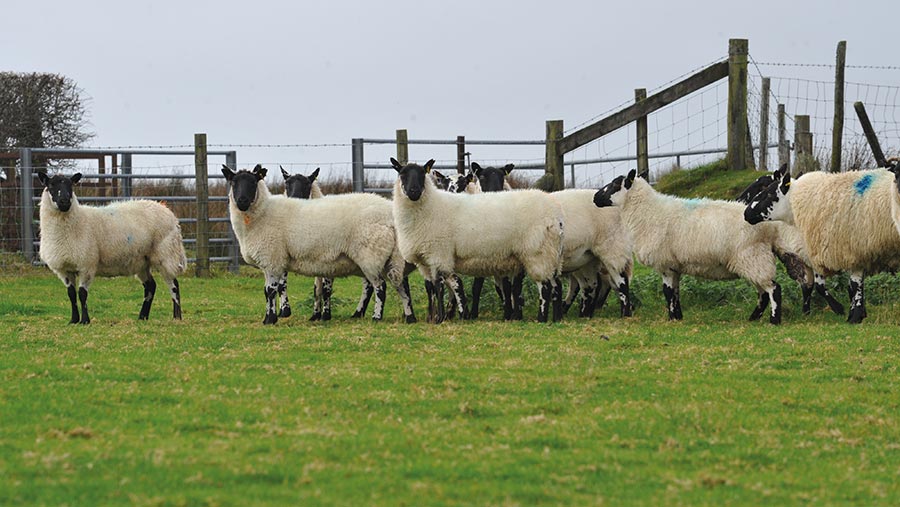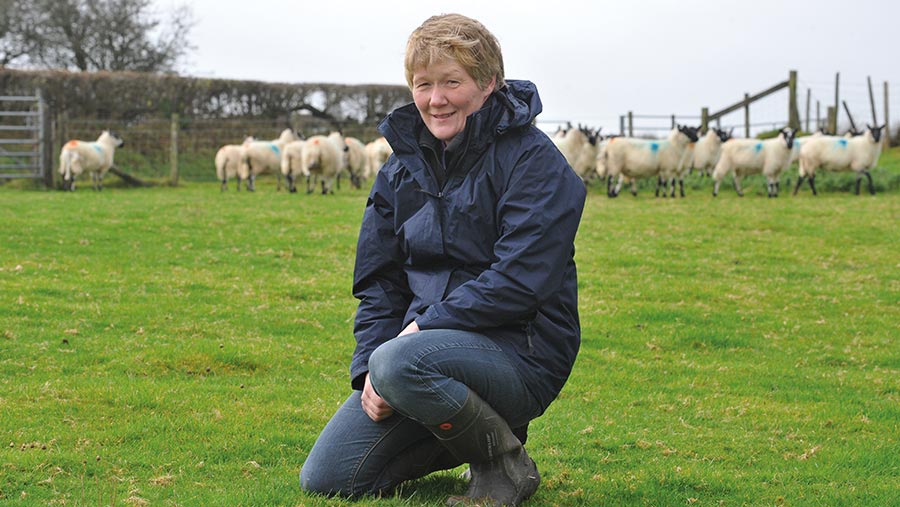Why keeping ewes in tip-top condition can help save on wormers
 © Debbie James
© Debbie James Keeping ewes at a good body condition score (BCS) in the weeks before and after lambing minimises worming requirements at a key point in the year, a new Welsh study has shown.
Worming ewes before and after lambing is a practice carried out by most UK sheep farms.
The rationale is that a weakening of their immune system at this time allows worms in their gut to produce more eggs.
These are then deposited on pasture in their dung and develop into larvae, presenting challenges to lambs later in the season.
See also: Scops issues latest advice on worming ewes for spring rise
But blanket treating all ewes on a farm is highly selective for anthelmintic resistance.
To mitigate this, the current Sustainable Control of Parasites (Scops) advice is to leave at least one in 10 of the fittest ewes untreated.
However, as the incidence of anthelmintic resistance continues to increase across the UK, reducing the number of ewes that need treatment to a minimum is now a priority. This was the basis of a new European Innovation Partnership (EIP).
The three-year EIP study involved five Welsh flocks and looked at how targeting the right ewes at the right time around lambing could reduce wormer use.
About the study
Twin-bearing ewes in good body condition, at BCS 3 or higher at the start of the observation period, were monitored from six weeks before lambing until eight weeks after.
Each group was faecal egg count (FEC) sampled weekly, along with 10 individual ewes in the mob that had their body condition and weight recorded.
Ration recommendations were based on forage analysis and the feed available outdoors.
Results
Evidence showed ewes that lost BCS around lambing – and the time this occurred – were both important factors.
There was significant variation in the extent, timing, and duration of the rise in egg output in ewes, known as the peri-parturient rise (PPR), between farms and among individual ewes.
This was relatively consistent from year to year on individual farms, said the project specialist, independent sheep expert Lesley Stubbings.
“This underlines the importance of not only selectively targeted ewe treatments, but the need to think about the timing of any treatments,” explained Ms Stubbings.
The results show that the PPR is linked to the time when the ewes are under the most pressure.
This occurred earlier on a farm where BCS loss is pre-lambing and much later after lambing where the BCS loss is during the lactation.
Achieving and maintaining BCS targets is therefore essential to minimise the number of ewes that are wormed, said Ms Stubbings.
“It was the individuals and the timing of a fall in BCS that was the indicator of an increased FEC in this project and therefore the need to worm,” Ms Stubbings added.
“If ewes are in good condition coming into the peri-parturient period, the findings of this project are that good nutrition and pasture planning will result in a very small proportion requiring treatment.”
The importance of BCS and nutrition
Fitter ewes are thought to produce fewer eggs, and these are the ones that can be left untreated, explained Ms Stubbings.
Forage analysis and effective diet formulation are key factors in maintaining BCS, she added.
Monitoring dry matter availability and predicting nutritional “pinch points” that could reduce BCS can help predict when ewe FECs should be monitored to confirm the timing of the PPR in egg counts.
“This is what the farmers in the group will use in the future to indicate those ewes in need of treatment, coupled with their knowledge of FEC patterns, and to determine the timing.’’
This is increasingly important because data collected on the worm species on these farms showed that T. Circumcinta was predominant. This is the species that mostly survived treatments, indicating the presence of resistance.
Simply using litter size and a set time as a guide for which ewes to treat, and when, is not accurate enough, warned Ms Stubbings.
She advised farmers to work out the right time to treat by monitoring FEC levels in their ewes in the run-up to, and after, lambing, as well as following BCS changes.
“There is an urgent need to remove unnecessary treatments to maintain the efficacy of anthelmintic groups that are still working on farms,” she warned.
Case study: Tirlan Farm, near Brechfa
Only worming ewes with a body condition score (BCS) less than 2.75 at lambing reduced anthelmintic use by 60% in one of the trial flocks.
Catrin George and her parents, Eric and Dilys Jones, run a flock of mostly Beulah Speckled Face ewes and some Poll Dorsets and Texels at Tirlan Farm, near Brechfa.

Catrin George © Debbie James
By monitoring ewe body condition and using faecal egg counts (FECs) to establish if, and when, worming was needed, treatments were only given to 40% of the 100 ewes they had in the trial.
“If we saw some [ewes] that were losing condition at scanning in January, we marked them and they were drenched at lambing along with any less than BCS 2.75,” said Mrs George.
In previous years, all twin-bearing ewes would have been routinely drenched.
“This trial has given us the confidence to target treatments, to only drench the ewes that need it,” said Mrs George.
Ewes are supplemented with big bale grass silage when grass production diminishes in mid-December and are housed in January in a purpose-built shed where they get ad-lib silage and a 20% protein concentrate.
The ration is matched to silage quality. In 2022, based on forage analysis, twin-bearing ewes were fed 0.25kg a head a day from four to six weeks pre-lambing, rising to 0.35kg a head a day two to four weeks pre-lambing and 0.55kg a head a day from two weeks to lambing.
For singles, the ration was 0.15kg a head a day two to four weeks pre-lambing and 0.25kg a head a day from two weeks to lambing.
Ewes are weighed at tupping, scanning, housing and when their lambs are eight weeks old and being weaned.
Before and after lambing, FEC sampling is carried out every fortnight to establish worm status and to inform the treatment plan. This allows the business to hold back on some routine doses.
“It used to be that we would drench them just in case,” admited Mrs George.
After drenching, a further FEC test is carried out to look for signs of resistance.
“We know that white drench is only 75% effective in our flock and are aware of the potential of resistance to other wormer groups, so it’s about protecting our future ability to treat worm burdens,” said Mrs George.
The farm vet receives the FEC results too and advises if there are issues that need addressing.
If a FEC indicates a high worm burden, sheep are moved to another field to graze, in rotation with the herd of 20 Limousin and Limousin-cross suckler cows and their calves.
